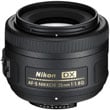Nikon D90
-
-
Written by Gordon Laing
Nikon D90 Movie Mode
Nikon D90 features : Lens, AF, sensor and release modes / Movie Mode
The Nikon D90 may feature a number of upgrades over its predecessor, but the one grabbing the most headlines is its new D-Movie mode – this isn’t surprising since the D90 is the first DSLR to offer the facility, although shortly after Nikon’s news, Canon announced its 5D Mark II would also feature movie recording. During the D90’s lifespan we’d also expect most other manufacturers to start offering DSLRs with movie modes.
But back to the pioneer: the D90 can record video at 320×216, 640×424 or 1280×720 pixels, all at 24fps and with optional mono sound recorded using a new built-in microphone just above the D90’s logo. The first two modes use the same 3:2 aspect ratio as the D90’s still images, while the 1280×720 mode is genuine high definition video in 16:9 using the 720p format.
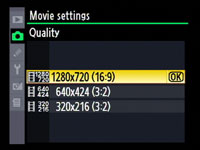 |
Video is compressed using the ageing Motion JPEG system and stored in an AVI wrapper. The maximum file size is 2GB, although additional restrictions limit the HD mode to five minutes and the lower resolution modes to 20 minutes. The D90 will stop recording at whichever comes first: the time limit or file size. Our clips worked out at an average of about 2.5MB per second for the HD mode with audio, which corresponds to a bit rate of around 20Mbit/s.
The D90’s movie mode is an extension of Live View: with Live View running, you simply press the OK button to start filming and again to stop. If you’re using the lower resolution modes, the image will fill the same screen area as normal Live View, but if you’re shooting in 720p, there’ll be thin grey bars at the top and bottom of the image to indicate the wider 16:9 frame.
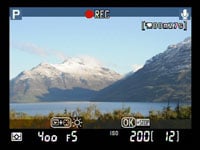 |
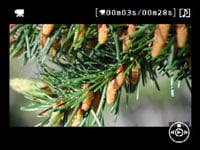 |
| ||
Since the D90 could be about to record stills in Live View mode, the camera allows you to manually set the aperture, shutter, ISO and almost any other value as normal. However only a handful of settings will have any impact if you start recording video instead. The aperture value can be set before shooting, but tests indicate smaller apertures are ignored; we’re confirming with Nikon, but believe the actual operating range may only be from the maximum aperture to around f8. Metering is fixed to Matrix and the shutter and sensitivity adjusted automatically while filming, although you can lock them or apply compensation before starting. VR is supported while filming to reduce camera-shake, but at the cost of higher power consumption.
Probably the biggest limitation though regards focusing: you can autofocus before you start filming, but once the D90 starts ‘rolling’, it becomes manual focus only. This is why having a lens with a smooth focusing ring and distance markings is very useful with the D90. The D90 manual also warns of banding under artificial light and ‘distortion’ if the camera is panned horizontally or an object moves at high speed through the frame.
That’s the theory, now for the practice. In use the D90’s video facility is a mixed bag: embrace the unique qualities a DSLR brings to video recording and you can enjoy spectacular results which would otherwise be difficult or impossible to achieve with a conventional camcorder. Fail to work within its limitations though, or simply become unlucky, and you can end up with very disappointing output.
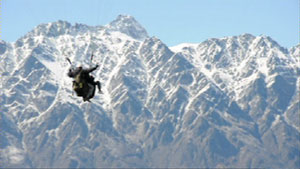 |
Let’s start with the good news. DSLRs have large sensors compared to traditional camcorders, which allows them to perform better in low light, and also achieve a smaller depth of field. In practice this bears-out with the D90. The D90’s video really is much cleaner in low light than a typical consumer camcorder (see lens caveats below), and the potential depth of field much smaller.
You can easily throw the background out of focus, or switch focus from one subject to another – a technique we’re all familiar with from professional filming, but something that’s almost impossible to achieve on a consumer camcorder. DSLRs also have the flexibility of interchangeable lenses, allowing you to film with exotic models including fisheyes and long telephotos, or those with macro or perspective control. Try doing that with your camcorder. The audio is also not bad considering it’s coming from a small built-in microphone, but beware as both focusing and zoom adjustments can be heard as faint scraping in the background.
 |
Now for the bad news. Hollywood and the pro movie industry may be used to manually focusing their lenses while filming, but most consumers aren’t. It takes some practice to get it right, and ideally requires a lens with a very smooth focusing ring and distance markings. It’s best-suited to rehearsed sequences with marked focus distances than spontaneous situations.
You’ll also notice zoom lenses for still cameras weren’t designed with video in mind: adjusting the focal length is just not as smooth, proportional or even quiet as a camcorder. It’s almost impossible to manually zoom the lens without severely shaking the camera, and DSLRs are simply the wrong shape to be held comfortably in front of your face while filming video for any length of time.
| ||
Speaking of lenses, it’s also important to compare like with like. If you buy the D90 kit, you may be surprised to find its video footage actually suffering from greater noise than your camcorder under low light. This is because the D90’s kit lens at f3.5-5.6 is typically four to eight times slower than an average camcorder lens. So under the same light, a camcorder could be operating at a low sensitivity, while the D90 could be pushed to a considerably higher one. If both cameras were operating at the same sensitivity, then the D90 would deliver cleaner results, but with the kit lens, the Nikon will almost certainly be working at a much higher sensitivity and effectively lose much of its advantage.
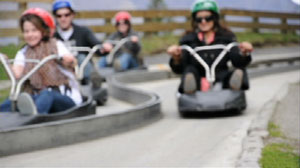 |
The D90’s video mode also suffers from motion artefacts often referred to as wobble, skew or jello. This is a well-known issue with CMOS sensors with rolling shutters which record each frame from top to bottom before returning to the top again for the next one. Should the camera or subject move during this process, the image can appear to tear, skew or wobble. Now many video cameras, both amateur and professional, employ CMOS sensors, but some suffer more from this effect than others. Sadly the D90 suffers more than most. Panning or zooming, fast-moving subjects or simply handheld work can often result in very undesirable artefacts.
This is all why most of Nikon’s approved sample footage is taken under ideal conditions where the camera will impress: fixed camera positions or gentle motion, along with its unique selling points of unusual lenses, low light or focus switching (the last two with optically fast lenses). Indeed, making the most of the D90’s video involves learning what kind of motions best avoid the skewing effect and working around them.
Finally, the D90’s video eats through both your card and battery at a rate of knots, so always carry spares or you will get caught short.
 |
 |
Ultimately the D90 will not replace your camcorder and if you try and use it in the same way for ‘normal’ shooting it will invariably disappoint or frustrate. Whether it’s the discomfort of holding the body, jerky zoom operation, necessity of manual focus, risk of skewing artefacts or the basic mono sound, it’s just not a viable video camera for all situations.
But the D90 can be a great complement to a camcorder, grabbing sequences with which would otherwise be compromised or even impossible. It has the potential to excel in low light and deliver an unusually small depth of field, and can also exploit unusual optics. In each of these respects it can thrash a conventional camcorder and approaches the capability of pro models costing a small fortune, but for the best effect you’ll need to learn its foibles and ditch the kit lens for something brighter with superior manual focus.
So if you’re an amateur film maker or a videographer wanting to insert a few unusual shots in your standard footage (differences in frame rates permitting), the D90 can be a wonderful tool. Just understand its limitations, work around them and realise it will never replace a normal video camera or the way you’d use it.
It would also be remiss of us not to mention Canon’s EOS 5D Mark II, the second ever DSLR to offer video. The EOS 5D Mark II trumps the D90 with nothing less than full 1080p video and stereo sound via an external microphone socket, all recorded using a modern H.264 codec. It does however cost just over two and a half times that of the D90, so is in a completely different category.
Note: despite featuring a built-in microphone and speaker, the D90 strangely does not offer the recording of voice annotations.
You can see example footage filmed with the D90’s movie mode in our Nikon D90 video tour.

